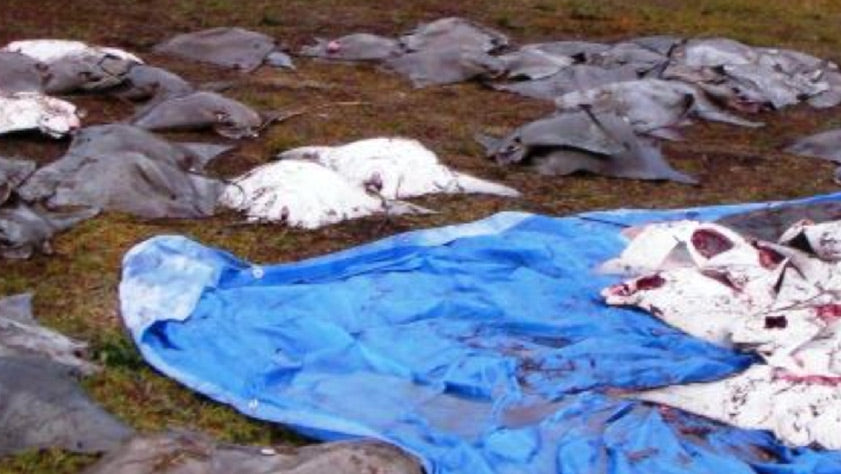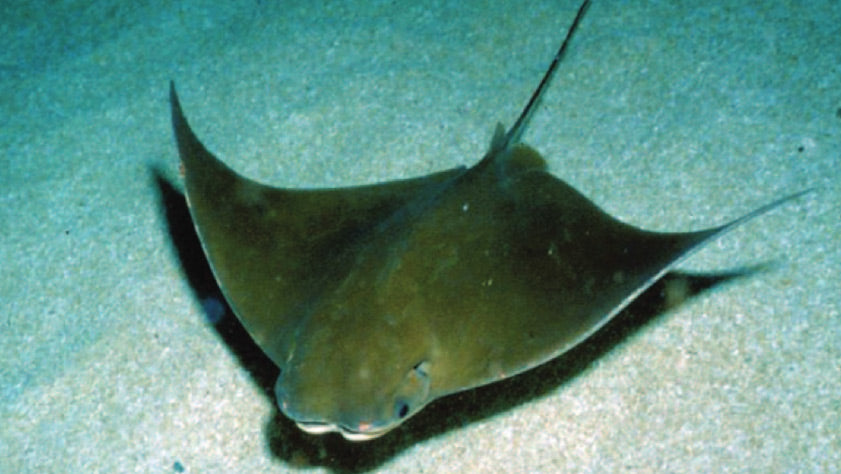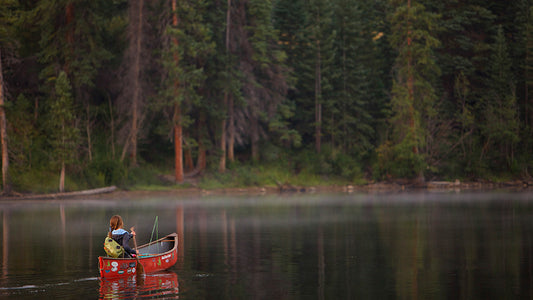UNDERSEA FLYERS PERSECUTED FOR UNCOMMITTED SINS
In 1608, Captain John Smith encountered a stranger dining on shellfish at the point where the Chesapeake Bay collects the Rappahannock River. Put off by what he perceived as an ugly visage, Smith drew his sword and delivered a grievous wound. But the stranger stabbed back, scoring a very palpable hit to the captain’s shoulder with a foil anointed with potent poison. Smith experienced such pain that his crew dug him a grave, but by evening, he was much recovered.
The site of the duel is called Stingray Point — because the stranger was a cow-nose ray.
Each spring, these shark cousins — some weighing as much as 50 pounds — waft north from Florida, “flying” on pectoral fins. From Texas to Massachusetts, they feast on crustaceans and small bivalves, excavating their prey by fanning sand and sediment.
In the Chesapeake Bay, the rays’ preferred diet had been soft-shell clams. However, the Bay’s soft-shells have been wiped out by human exploitation, disease (aided by human pollution), and massive slugs of fresh water running off paved and cleared land areas. So the rays have been forced to switch to eating razor clams and, sometimes, juvenile oysters. (They’re incapable of eating adult oysters.) That’s where the trouble begins.
Lots of sea creatures eat oysters. Blue crabs, black drum, and red drum each probably eat more Chesapeake Bay oysters than the rays do. But crabs and drum are popular, so no one complains about them. The Bay’s oysters are vastly depleted for all sorts of reasons — virtually all caused by humans. There is absolutely no evidence that cownose rays have had anything to do with that depletion, but they make handy scapegoats — like blaming coyotes for the winter deaths of malnourished deer in north-country clearcuts.
So today, cownose rays are being treated pretty much the same way Smith treated them.

REELING IN RAYS
Bowfishing for cownose rays is a fast-growing sport in the Chesapeake Bay and throughout most of the rays’ U.S. range. Any reel would burn out on the first run, so when you stick one, you let it take the line, then chase the attached buoy.
There is no data on the number of rays killed each year in the Chesapeake Bay, but from posts on bowhunting forums, it’s clear that the numbers are high — and that very little meat is utilized. For example, asked if cownose rays are edible, one bowfisher on a Maryland Shooters forum wrote, “I usually kill 800 a year.... You can have all you want to experiment with.” That post is not an outlier — the theme keeps repeating itself across social media.
Conscientious fishing guides such as Captain Marc Spagnola of Dusk to Dawn Bowfishing offer to clean their clients’ kills, but they get few takers. Ray meat is dark and bloody, more like beef than fish. It sells well in Asian markets, but an effort by the seafood industry to create a big American market for rays has bombed. Still, Spagnola tells me that bowfishing for cownose rays in the Chesapeake Bay has “grown and grown.”
Hundreds of rays are killed in bowfishing tournaments. “Wasting these critters in tournaments makes me sick,” declares John Page Williams, senior naturalist for the Chesapeake Bay Foundation. Williams is trying to promote appreciation for cownose rays and has no problem with killing a few for the table — he does so himself (with rod and reel).
In defense of the bowfishers, they’ve been told for years that they’re providing a valuable service by containing a Biblical plague of rays brought on by a decline of coastal sharks, the rays’ main predator. To fix this alleged imbalance, the commercial fish/shellfish industry has given the cownose ray the more palatable-sounding name of “Chesapeake ray,” pushed for a bounty on rays, and hatched a media blitz called “Eat a Ray, Save the Bay.”
However, eliminating cownose rays will do nothing to save the Bay or its oyster populations.
HOW NOT TO SAVE THE BAY
Dr. Dean Grubbs, associate director of research for Florida State University’s Coastal and Marine Laboratory, explains that the persecution of rays is misdirected. “Every 5 to 10 years, we hear about this cownose ray ‘explosion’,” says Grubbs. However, problems with oyster populations started well before any increase in ray populations.
Grubbs notes that female rays deliver one pup annually and only after their eighth year, rendering impossible the kind of population explosion shellfish growers talk about. He also calls the shark-decline theory “wrong on all levels,” pointing out that populations of coastal sharks rebounded well before “the current [alleged ray explosion] hit the fan in 2006.”
At that time, Grubbs worked for the Virginia Institute of Marine Science. He urged caution as the Institute and state resource agencies spent hundreds of thousands of dollars promoting commercial markets for cownose rays. The Virginia Marine Resources Commission paid fishermen to catch rays and even sent an envoy to South Korea in an effort to create a commercial market for them there.
South Koreans adore ray meat and import $18 million worth of it each year. Demand in that country quickly exhausted the stock of Brazilian cownose rays, a species nearly identical to our own. The Brazilian cownose is now listed as endangered by the International Union for Conservation of Nature.
Chesapeake Bay states have no closed season for cownose rays, no bag limit, no management plan, and no plans for management. Officials from the Virginia Marine Resources Commission and Maryland Department of Natural Resources (DNR) inform me that because there’s not yet a major fishery for cownose rays, there’s no population assessment. And because there’s no population assessment, there’s no data for management.
In response to questions from the public about ray harvests, the Maryland DNR stated in a press release, “There is currently very little scientific data available on the cownose ray population in the Chesapeake Bay and given this limited information, the DNR cannot put a management plan in place at the state level. However, the DNR is currently working with the Environmental Protection Agency (EPA) and other Bay states to pull together a workshop on the species and discuss possible management actions across the watershed in the future.”
LOCKING EMPTY BARNS
It has been ever thus with marine fish — and not just in the Chesapeake Bay. We don’t act; we react. Management doesn’t happen until a stock is critically depleted, by which time it may be too late. In the 1970s, we couldn’t give coastal sharks away; by the 1990s, after we created a commercial market, they were commercially extinct.
Will the increasing take by bowfishers crash the cownose ray population? No one can say. Whatever the effect, it is sure to be dwarfed if a major fishery gets going.
Our ongoing duel with cownose rays evokes three important questions: How ethical is it to encourage depopulation of a native species based strictly on hearsay? How ethical is it to promote markets for fish we don’t manage, whose populations we don’t assess, and for which the take might be not be sustainable? And how ethical is it to hunt and waste a native species, even if the take is sustainable?
Ted Williams, a lifelong angler and hunter, writes about fish and wildlife for national publications.



